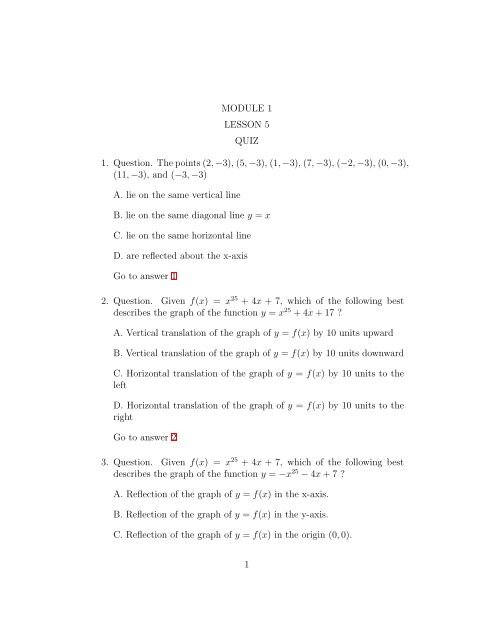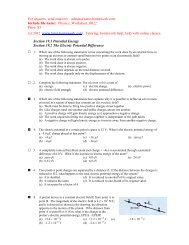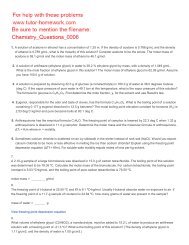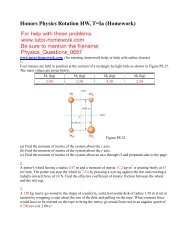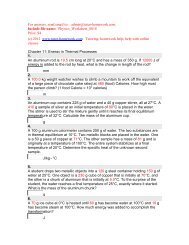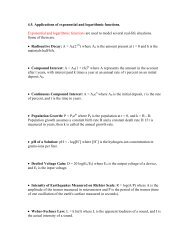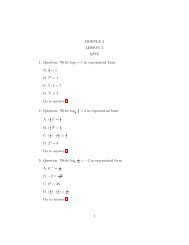MODULE 1 LESSON 5 QUIZ 1. Question. The points (2,â3), (5,â3)
MODULE 1 LESSON 5 QUIZ 1. Question. The points (2,â3), (5,â3)
MODULE 1 LESSON 5 QUIZ 1. Question. The points (2,â3), (5,â3)
You also want an ePaper? Increase the reach of your titles
YUMPU automatically turns print PDFs into web optimized ePapers that Google loves.
<strong>MODULE</strong> 1<strong>LESSON</strong> 5<strong>QUIZ</strong><strong>1.</strong> <strong>Question</strong>. <strong>The</strong> <strong>points</strong> (2, −3), (5, −3), (1, −3), (7, −3), (−2, −3), (0, −3),(11, −3), and (−3, −3)A. lie on the same vertical lineB. lie on the same diagonal line y = xC. lie on the same horizontal lineD. are reflected about the x-axisGo to answer 12. <strong>Question</strong>. Given f(x) = x 25 + 4x + 7, which of the following bestdescribes the graph of the function y = x 25 + 4x + 17 ?A. Vertical translation of the graph of y = f(x) by 10 units upwardB. Vertical translation of the graph of y = f(x) by 10 units downwardC. Horizontal translation of the graph of y = f(x) by 10 units to theleftD. Horizontal translation of the graph of y = f(x) by 10 units to therightGo to answer 23. <strong>Question</strong>. Given f(x) = x 25 + 4x + 7, which of the following bestdescribes the graph of the function y = −x 25 − 4x + 7 ?A. Reflection of the graph of y = f(x) in the x-axis.B. Reflection of the graph of y = f(x) in the y-axis.C. Reflection of the graph of y = f(x) in the origin (0, 0).1
D. Reflection of the graph of y = f(x) in the diagonal line y = x.Go to answer 34. <strong>Question</strong>. Given f(x) = x 5 + 4x 2 + 7x + 1, which of the followingequations best describes the function y = g(x) whose graph is obtainedfrom the graph of y = f(x) by the reflection of the graph y = f(x) inthe x-axis?A. g(x) = −x 5 − 4x 2 − 7x + 1B. g(x) = x 5 − 4x 2 + 7x − 1C. g(x) = −x 5 + 4x 2 − 7x + 1D. g(x) = −x 5 − 4x 2 − 7x − 1Go to answer 4Now go to the series of questions on the next page.2
SERIES OF QUESTIONS. For the <strong>Question</strong>s from 5 through 11, let Pbe the point (−3, 2) and let us consider the following eight <strong>points</strong>:A. (3, −2)B. (3, 2)C. (−3, 7)D. (2, 2)E. (−3, −2)F. (−8, 2)G. (−3, −3)H. (2, −3).5. <strong>Question</strong>. Which of the <strong>points</strong> above is obtained from the point P bythe vertical translation 5 units upward?Go to answer 56. <strong>Question</strong>. Which of the <strong>points</strong> above is obtained from the point P bythe vertical translation 5 units downward?Go to answer 67. <strong>Question</strong>. Which of the <strong>points</strong> above is obtained from the point P bythe horizontal translation 5 units to the right?Go to answer 78. <strong>Question</strong>. Which of the <strong>points</strong> above is obtained from the point P bythe horizontal translation 5 units to the left?Go to answer 89. <strong>Question</strong>. Which of the <strong>points</strong> above is obtained from the point P bythe reflection in the y-axis?3
Go to answer 910. <strong>Question</strong>. Which of the <strong>points</strong> above is obtained from the point P bythe reflection in the x-axis?Go to answer 101<strong>1.</strong> <strong>Question</strong>. Which of the <strong>points</strong> above is obtained from the point P bythe reflection in the diagonal line y = x?Go to answer 11SERIES OF QUESTIONS. For the <strong>Question</strong>s from 12 through 18, lety = f(x) be a function given by the equation y = 8x 3 + 5 and let usconsider the following eight equations:A. x = 8y 3 + 5B. y = 8x 3C. y = −8x 3 + 5D. y = 8x 3 + 10E. y = −8x 3 − 5F. y = 8(x + 5) 3 + 5G. y = 8x 3 − 5H. y = 8(x − 5) 3 + 5.12. <strong>Question</strong>. Which of the equations above describes the function obtainedfrom y = 8x 3 + 5 by the vertical translation 5 units upward?Go to answer 1213. <strong>Question</strong>. Which of the equations above describes the function obtainedfrom y = 8x 3 + 5 by the vertical translation 5 units downward?Go to answer 134
14. <strong>Question</strong>. Which of the equations above describes the function obtainedfrom y = 8x 3 + 5 by the horizontal translation 5 units to theright?Go to answer 1415. <strong>Question</strong>. Which of the equations above describes the function obtainedfrom y = 8x 3 + 5 by the horizontal translation 5 units to theleft?Go to answer 1516. <strong>Question</strong>. Which of the equations above describes the function obtainedfrom y = 8x 3 + 5 by the the reflection in the y-axis?Go to answer 1617. <strong>Question</strong>. Which of the equations above describes the function obtainedfrom y = 8x 3 + 5 by the the reflection in the x-axis?Go to answer 1718. <strong>Question</strong>. Which of the equations above describes the function obtainedfrom y = 8x 3 + 5 by the the reflection in the diagonal liney = x?Go to answer 185
ANSWERS<strong>1.</strong> Answer to <strong>Question</strong> 1 is ”C”.Go back 12. Answer to <strong>Question</strong> 2 is ”A”.Go back 23. Answer to <strong>Question</strong> 3 is ”B”.Go back 34. Answer to <strong>Question</strong> 4 is ”D”.Go back 45. Answer to <strong>Question</strong> 5 is ”C”.Go back 56. Answer to <strong>Question</strong> 6 is ”G”.Go back 67. Answer to <strong>Question</strong> 7 is ”D”.Go back 78. Answer to <strong>Question</strong> 8 is ”F”.Go back 89. Answer to <strong>Question</strong> 9 is ”B”.Go back 96
10. Answer to <strong>Question</strong> 10 is ”E”.Go back 101<strong>1.</strong> Answer to <strong>Question</strong> 11 is ”H”.Go back 1112. Answer to <strong>Question</strong> 12 is ”D”.Go back 1213. Answer to <strong>Question</strong> 13 is ”B”.Go back 1314. Answer to <strong>Question</strong> 14 is ”H”.Go back 1415. Answer to <strong>Question</strong> 15 is ”F”.Go back 1516. Answer to <strong>Question</strong> 16 is ”C”.Go back 1617. Answer to <strong>Question</strong> 17 is ”E”.Go back 1718. Answer to <strong>Question</strong> 18 is ”A”.Go back 187


